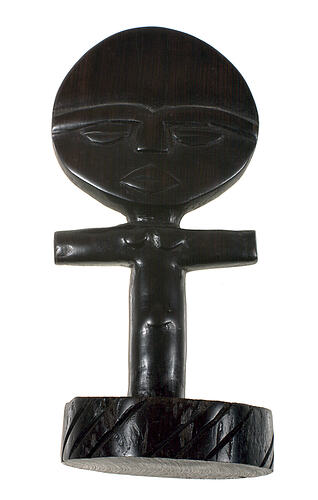Summary
National doll made to represent those traditionally made by the Asante (Ashanti) people, it was was given to Monica Gates by her mother who purchased it on an African safari from the Ivory Coast to Uganda in 1976.
This type of doll known as an Akua'ba, was traditionally part of treatments to encourage infertile women to conceive. The priest consecrates both the figure and the woman, who treats it as if it were her own child until she gives birth, dressing it, holding it etc. Successful dolls may be given back to the priest for display on his shrine or kept by the woman, some women even keep their akua'ba if they do not conceive. The dolls usually are female, with a static pose, disc-shaped enlarged head, black stained finish, and simple incised decoration.
Since the 1960s these dolls have become a popular item of tourist and export art. No longer are these dolls made only by the Asante in Ghana they are now carved by crafts people across Africa to sell to tourists, reproductions of these dolls are also being made cheaply in Asia for export as 'African decor'.
The Gates collection contains 170 national dolls from 74 different countries and some correspondence relating to the acquisition of several of the dolls. The costumes of the dolls represent national costumes from the 19th Century to the 1990s. Monica Gates collected or was given these dolls between 1957 and 1990.
These dolls were purchased as souvenirs of particular countries and like many mass produced souvenirs they are often not accurate representations of a particular country or region, and may actually better reflect neighbouring counties or regions. This occurs because costumes are often stylised and simplified resulting dolls wearing generic costume elements which are common to many countries/regions. Often the fabrics and decorations used are selected to make the dolls cheap and easy to manufacture and aesthetically pleasing. This can result in the fabrics, colours and decorations of the doll's clothing having little or no reflection of the costume associated with a particular country or region they are meant to be representative of.
Physical Description
Dark, carved wooden doll with a large circular head. On the front there are stylised facial features carved. The body has arms straightened out to the sides and a straight torso with no legs defined. There are some anatomical features carved on the front of the body, the back bear. It has thick circular wooden base with some decorative carvings on it.
More Information
-
Collecting Areas
-
Acquisition Information
Purchase
-
Place Made
-
User
-
Other Association (See Comments)
Ghana
This type of doll is traditionally made by the Asante people of Ghana -
Classification
-
Category
-
Discipline
-
Type of item
-
overall dimensions
9 cm (Length), 8 cm (Width), 20 cm (Height)
-
References
Elisabeth L. Cameron. 'In Search of Children: Dolls and Agency in Africa', African Arts, Vol. 30, No. 2 (Spring, 1997), pp. 18-33 Norma H. Wolff. 'African Artisans and the Global Market: The Case of Ghanaian 'Fertility Dolls', African Economic History, No. 32, (2004), pp. 123-141
-
Keywords
Children's Play, Clothing, Cultural Awareness, Cultural Beliefs, Dolls, National Costumes, National Identity, Souvenirs
